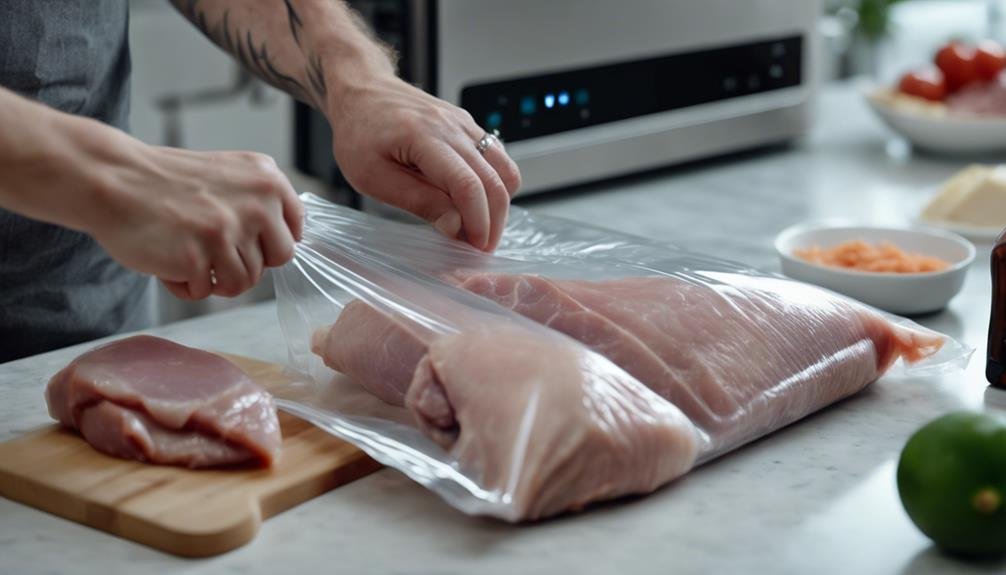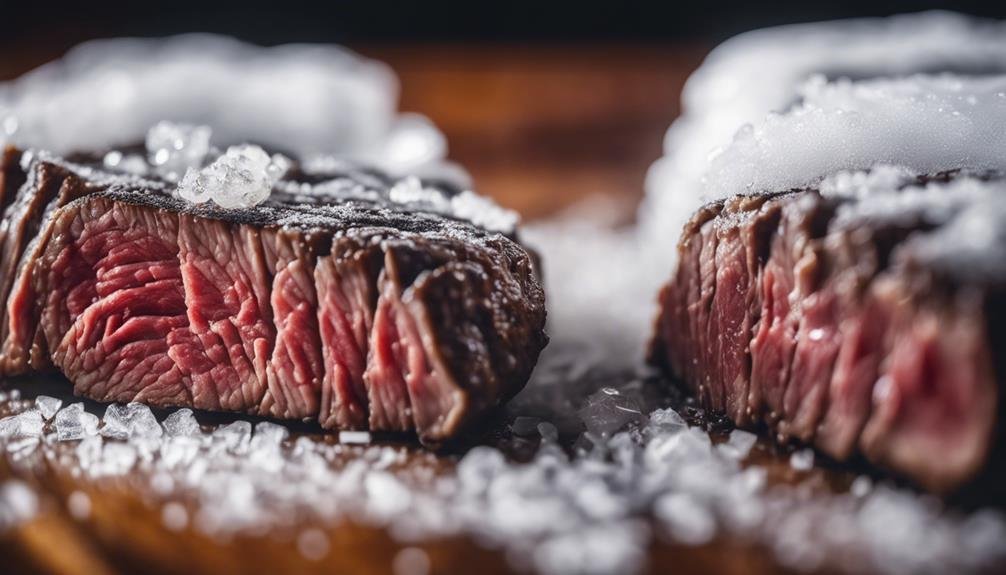Vacuum sealing is your best defense against freezer burn, effectively preserving the quality and taste of your frozen foods. It works by removing air from the packaging, creating an airtight environment that prevents moisture loss and ice crystal formation. This process eliminates oxygen exposure, which is the main culprit behind freezer burn. By using a vacuum sealer, you'll maintain the original texture, flavor, and freshness of your stored items for much longer periods. It's an efficient method for extending shelf life and ensuring your frozen foods remain in top condition. Discover how this simple technique can revolutionize your food storage practices and save you money in the long run.
Understanding Freezer Burn
To grasp why vacuum sealing is so effective, you'll need to understand what freezer burn is and how it affects your food. Freezer burn occurs when moisture escapes from your frozen food, forming ice crystals on its surface. This process leads to significant changes in both the texture and flavor of your stored items.
When you open your freezer and find food covered in frost or ice, that's freezer burn in action. It's not harmful to eat, but you'll notice a difference in quality. Your food will be drier and may not taste as good as it originally did. This is because the moisture loss alters the food's structure at a cellular level.
The formation of ice crystals is a key indicator of freezer burn. These crystals draw moisture away from your food, leaving it dehydrated and less palatable. You might notice tough, leathery textures in meats or a loss of flavor in fruits and vegetables.
While freezer-burned food is safe to consume, it's often not as enjoyable. Understanding this process helps you appreciate why vacuum sealing is such an effective method for preserving your food's quality and taste.
The Science Behind Vacuum Sealing
Vacuum sealing's freezer burn-fighting power lies in its ability to create an airtight environment around your food. This scientific process effectively removes air from the packaging, which is essential in preventing freezer burn. When you vacuum seal your food, you're eliminating the oxygen that would normally come into contact with it. This absence of air is vital to maintaining your food's quality during long-term freezer storage.
Here's how it works: Without air in the package, there's no moisture to form those pesky ice crystals that cause freezer burn. The vacuum-sealed bag creates a barrier that protects your food from the dry, cold air in your freezer.
This preservation method not only prevents freezer burn but also helps maintain the texture and flavor of your food.
Benefits of Vacuum Sealing
Several key advantages make vacuum sealing an invaluable technique for preserving your food's quality and extending its shelf life. When you use a vacuum sealer, you're effectively preventing freezer burn by creating an airtight seal that eliminates air exposure. This process notably extends the storage life of your food by reducing oxygen levels in the packaging.
One of the primary benefits of vacuum sealing is its ability to maintain the original texture, taste, and quality of your stored items. Unlike standard poly bags, vacuum bags are specifically designed to prevent air seepage, ensuring your food stays fresh for longer periods.
Here's a quick comparison of vacuum sealing benefits:
| Benefit | With Vacuum Sealing | Without Vacuum Sealing |
|---|---|---|
| Air Exposure | Eliminated | Present |
| Storage Life | Extended | Normal |
| Food Quality | Maintained | Diminished |
| Freezer Burn | Prevented | Possible |
Vacuum Sealing Equipment Options
When it comes to choosing vacuum sealing equipment, you'll find a range of options to suit different needs and budgets. The FoodSaver system is a popular choice, offering an effective solution to prevent freezer burn and extend food shelf life. This system creates an airtight seal that removes air from packaging, effectively eliminating oxygen exposure and moisture loss.
You'll discover that vacuum sealing equipment comes in various sizes and configurations. Some models are compact and designed for occasional use, while others are larger and more suitable for frequent sealing. Many systems include features like automatic moisture detection and built-in bag cutters for added convenience.
When selecting your equipment, consider factors such as ease of use, sealing speed, and compatibility with different types of bags and containers. Look for models that offer adjustable settings to accommodate various food types and textures.
Investing in quality vacuum sealing equipment is a practical way to maintain the freshness and integrity of your stored food items. By choosing the right system, you'll be able to prevent freezer burn, preserve food quality, and reduce waste, ultimately saving money in the long run.
Step-by-Step Vacuum Sealing Process

The process of vacuum sealing your food is straightforward and can be mastered with a few simple steps. Begin by selecting the food you want to protect from freezer burn and placing it in a suitable vacuum-seal bag. Make sure the bag is large enough to accommodate the food with some extra space for sealing.
Next, arrange the food evenly within the bag, avoiding overfilling. If you're sealing liquids or moist foods, consider pre-freezing them to prevent moisture from interfering with the seal. Place the open end of the bag into your vacuum sealer, following the manufacturer's instructions for proper alignment.
Activate the vacuum sealer, which will remove the air from the bag. As the air is extracted, you'll notice the bag tightening around the food. Once the air is removed, the machine will automatically seal the bag, creating an airtight barrier.
After sealing, inspect the bag to make sure a proper seal has formed. Label the package with the contents and date for easy identification.
Best Foods for Vacuum Sealing
Now that you've mastered the vacuum sealing process, let's explore which foods benefit most from this preservation method. When it comes to frozen foods, vacuum sealing is your best ally against freezer burn.
You'll find that meats, poultry, and fish are prime candidates for this technique. By removing as much air as possible from the plastic bag, you're creating an environment that inhibits moisture loss and ice crystal formation, keeping your proteins fresh and flavorful.
But don't stop there! Fruits and vegetables also thrive when vacuum sealed. You can preserve their texture and nutritional value for longer periods. Even baked goods can be protected from freezer burn, allowing you to enjoy homemade treats weeks or months later.
Don't forget about your favorite soups, stews, and sauces. These liquid-based dishes are particularly susceptible to freezer burn, but vacuum sealing can keep them tasting just-made. By creating an airtight seal, you're extending the shelf life of all these food items.
Common Vacuum Sealing Mistakes

Despite its importance in preventing freezer burn, vacuum sealing isn't foolproof if you're making these common mistakes. Your sealing technique plays a vital role in the process, and improper execution can leave small gaps for air to enter, potentially leading to freezer burn.
When you're vacuum sealing, make sure you're applying adequate pressure to eliminate air pockets within the package, as these can increase the risk of freezer burn.
Another mistake to avoid is neglecting the sealing area. If you don't keep it clean and dry, you're compromising the effectiveness of the vacuum seal, leaving room for air and moisture to cause freezer burn.
Additionally, using damaged or worn-out vacuum sealing bags can reduce the quality of the seal, making your food more susceptible to freezer burn.
Don't forget to check the seal integrity after vacuum sealing. Failing to do so can allow air to seep back in over time, potentially causing freezer burn.
Alternatives to Vacuum Sealing
While vacuum sealing is effective, you've got several other options to protect your food from freezer burn. If you don't have a vacuum sealer, you can use wax freezer paper or butcher paper as barriers against freezer air. These materials help prevent water evaporation and maintain food quality.
Another technique is the water displacement method. Submerge a barely closed freezer bag in water to force out air before sealing. This mimics the air removal process of a vacuum sealer, reducing the risk of freezer burn.
Here's a comparison of freezing techniques:
| Technique | Air Removal | Ease of Use | Cost-Effective |
|---|---|---|---|
| Vacuum Sealer | Excellent | High | Moderate |
| Wax Paper | Good | Medium | High |
| Water Displacement | Very Good | Medium | High |
| Double Wrapping | Good | Low | High |
For bread, slice it before freezing and remove as much air as possible from the bag. When dealing with large meat packs, rewrap individual portions and ensure airtight packaging. These methods help extend shelf life and preserve food quality.
Long-Term Food Storage Tips

For long-term food storage, you'll need to go beyond vacuum sealing and employ a variety of techniques to keep your provisions fresh and safe. While vacuum sealing is an excellent method to prevent freezer burn and extend shelf life, it's just one part of a thorough approach to food preservation.
To maximize your food storage efforts, start by organizing your freezer. Keep it at 0°F (-18°C) or below to maintain ideal conditions. Label all packages with the contents and date of storage to track freshness. Rotate your stock, using older items first to minimize food waste.
When vacuum sealing, remove as much air as possible to create an airtight environment. This will greatly reduce the risk of freezer burn and preserve food quality. For items you can't vacuum seal, use freezer-safe containers or high-quality freezer bags, removing excess air before sealing.
Consider blanching vegetables before freezing to preserve color, texture, and nutrients. For meats, wrap them tightly in plastic wrap before vacuum sealing for an extra layer of protection. By combining these techniques with vacuum sealing, you'll ensure your food stays fresh and tasty for extended periods.
Vacuum Sealing Vs. Other Methods
Vacuum sealing stands out among food preservation methods due to its superior ability to remove air and prevent freezer burn. Unlike standard storage methods, such as using plastic containers or zip-top bags, vacuum sealing creates an airtight environment that greatly reduces oxygen exposure.
When you use vacuum sealing, you're not just removing air from the package; you're creating a barrier that prevents air from seeping back in. This complete air reduction is essential in maintaining the quality, texture, and taste of your stored items. Traditional storage methods can't match this level of protection, leaving your food vulnerable to freezer burn and degradation over time.
Vacuum sealing also extends the shelf life of your food more effectively than other methods. By eliminating oxygen, you're stopping the process that leads to product deterioration. This means you can store your food for longer periods without sacrificing quality.
While other methods may offer some protection, they simply can't compete with the thorough air reduction and sealing capabilities of vacuum packaging. If you're looking for the most effective way to prevent freezer burn and preserve your food's freshness, vacuum sealing is your best choice.
Conclusion
You've learned how vacuum sealing protects your food, extends its shelf life, and preserves its quality.
You've discovered the science, benefits, and process of vacuum sealing.
You've explored equipment options, avoided common mistakes, and considered alternatives.
You've gained insights into long-term food storage and compared vacuum sealing to other methods.
Now, you're equipped to keep your frozen foods fresher, tastier, and free from freezer burn.
Put your knowledge into practice and enjoy better-preserved meals.
